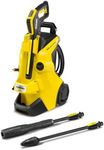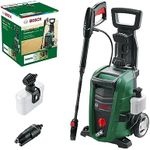Buying Guide for the Best Electric Power Washers
Electric power washers are versatile tools that can help you clean various surfaces with ease, from patios and driveways to cars and outdoor furniture. When choosing the right electric power washer, it's important to consider several key specifications to ensure you get the best fit for your needs. Understanding these specs will help you make an informed decision and find a model that suits your cleaning tasks effectively.PSI (Pounds per Square Inch)PSI measures the pressure output of the power washer. This spec is crucial because it determines how powerful the washer is and how effectively it can clean tough stains and dirt. Lower PSI (around 1300-1800) is suitable for light-duty tasks like washing cars and outdoor furniture. Medium PSI (2000-2800) is ideal for cleaning decks, patios, and driveways. Higher PSI (3000 and above) is best for heavy-duty tasks like stripping paint or cleaning large areas. Choose a PSI level based on the type of cleaning you plan to do most often.
GPM (Gallons per Minute)GPM indicates the water flow rate of the power washer. This spec is important because it affects how quickly you can clean a surface. Lower GPM (1.2-1.5) is suitable for smaller, less dirty areas. Medium GPM (1.5-2.5) is good for moderate cleaning tasks. Higher GPM (2.5 and above) is ideal for large, heavily soiled areas. Consider the size and dirtiness of the surfaces you need to clean when choosing the GPM.
Motor TypeElectric power washers typically come with either universal motors or induction motors. Universal motors are lighter and less expensive but tend to be noisier and less durable. Induction motors are quieter, more durable, and generally offer better performance but are heavier and more expensive. If you plan to use your power washer frequently or for extended periods, an induction motor may be a better choice. For occasional use, a universal motor might suffice.
Nozzle TypesNozzles control the spray pattern and pressure of the water. Different tasks require different nozzle types. Common nozzle types include 0-degree (high pressure, pinpoint spray), 15-degree (high pressure, narrow spray), 25-degree (medium pressure, wider spray), 40-degree (low pressure, wide spray), and soap nozzle (low pressure, used for applying detergent). Choose a power washer that comes with a variety of nozzles to handle different cleaning tasks effectively.
Hose LengthThe length of the hose affects your reach and convenience while cleaning. Shorter hoses (20-25 feet) are easier to manage but may require frequent repositioning of the washer. Longer hoses (30-50 feet) provide greater reach and flexibility, allowing you to clean larger areas without moving the washer as often. Consider the size of the area you need to clean and how much mobility you require when choosing the hose length.
PortabilityPortability refers to how easy it is to move the power washer around. This is influenced by the weight, design, and presence of wheels. Lightweight models are easier to carry but may have less power. Models with wheels are easier to move around, especially if they are heavier. If you need to transport the washer frequently or use it in different locations, look for a model that offers good portability features.
Detergent TankA detergent tank allows you to apply soap or cleaning solutions directly through the power washer. This spec is important for tasks that require more than just water to clean effectively, such as washing cars or heavily soiled surfaces. Some models have built-in detergent tanks, while others require external containers. If you plan to use detergents regularly, a built-in tank can be more convenient.


















